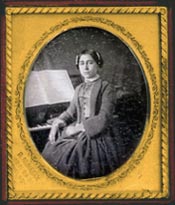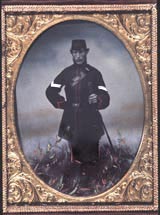|
|
|
We treasure the example we have collected of early photographic processes. These are often called "hard images" because most are on a ridged base such as metal or glass. They are one-of-a-kind, since the plate that is exposed in the camera becomes the final image. The only way to get more is to make photographic copies. Most are enclosed in leather or thermoplastic cases or in frames, although ferrotypes or tintypes are often in paper folders or mats or unprotected. We have included them in this section because they are so closely related to Ambrotypes. |
||||
Daguerreotypes |
Ambrotypes |
Tintypes/Ferrotypes |
||
 |
 |
 |
||
| View more examples from: Our Daguerreotype Collection |
View more examples from: Our Ambrotype Collection |
View more examples from: Our Tintype/Ferrotype Collection |
||
| What is a daguerreotype? The daguerreotype, a fragile mercury image on a silver plated copper sheet, was the first widely successful commercial photographic process. Invented by Jacque Mande Louis Daguerre it was announced in Paris in 1839. It answered a deep felt need for portraits which before the introduction of photography were only available as drawings or paintings. The fragile images were bound under glass and enclosed in cases adapted from those in which miniature paintings were housed. Some were shown in frames but because of the reflective nature of the process this was not as common or successful. From its introduction in 1839 until it was supplanted by the introduction of collodian in the 1850s the daguerreotype was the most widely practiced photographic process. |
What is an ambrotype? Frederick Scott Archer invented the wet collodion process which was introduced in 1851. In addition to replacing the paper negatives of the period for the making of paper prints it was also discovered that it could produce a one-of-a-kind hard image that was cheaper and easier than the daguerreotype. When a thin collodion negative on glass is backed with black it appears positive. The ambrotype is a sensitized sheet of glass with a dark coating or backing. Some are coated on dark ruby glass. Because it was on a glass base the ambrotype was fragile and was presented in cases like daguerreotypes or in frames. The cheaper and easier ambrotype replaced the daguerreotype in the 1850s. They lacked
the beautiful tonal range
of the daguerreotype and as unique images could not compete with paper
prints from collodion negatives. |
What is a ferrotype? Ferrotypes, also called tintypes, are collodion negatives that appear positive on a dark Japanned sheet of iron. They were also made on other ridged dark material. We have one on leather and several on stiff paper. They were cheaper and less fragile than their close relation, the Ambrotype. Many thousands were made from the introduction in the 1850s and they continued to be made at beaches and carnivals into the second decade of the 20th century. They were sometimes cased like daguerreotypes but often enclosed in a paper mat or left unprotected. |
||
|
At the top of this column: A woman sits at a piano. We think of her as "The Music Teacher". |
At the top of this column:
A civil war soldier stands in a field of painted grass. |
At the top of this column: A sign painter paints "J. KURTZ PHOTOGRAPHER" on a sign. |
||
Return to The Collection of Collections page Collection of Collections Site Map Contact us at studio@brightbytes.com **NOTE** All items on the Collection of Collections web site are in our private collection and are NOT for sale. From time to time duplicate items from our collection will be offered for sale in the Do You Remember This? shop on the GoAntiques cyber mall. Visit the Do You Remember This? inventory page for photographica and toaster related collectibles. Please feel free to write us if you want to chat or share information about areas we collect but we will NOT give appraisals. © Bright Bytes Studio - Do not use images without permission Updated on 11/2005 |